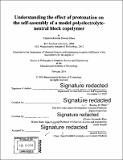Understanding the effect of protonation on the self-assembly of a model polyelectrolyte-neutral block copolymer
Author(s)
Stewart-Sloan, Charlotte (Charlotte Roberta)
DownloadFull printable version (23.48Mb)
Other Contributors
Massachusetts Institute of Technology. Department of Materials Science and Engineering.
Advisor
Bradley D. Olsen.
Terms of use
Metadata
Show full item recordAbstract
Charge-containing polymers are used in a wide variety of commercial products including fuel cell membranes, heat sealing packages, and golf ball covers. Traditionally made as random copolymers of charged and uncharged monomers, morphological understanding and control is limited due to the lack of long range order and small length scale of the structural inhomogeneities. Moreover, the charge functionality is typically introduced in a permanent way that is not modifiable after synthesis, locking in a chemistry and structure that may not be optimal for the ultimate application. This thesis develops and studies the morphologies of a model block copolymer which is controllably charged in a novel way: by protonating a weak base. This polymer is composed of one hydrophilic but uncharged block, poly(oligoethylene glycol methyl ether methacrylate) (POEGMA), and one weak polyelectrolyte, poly(2-vinylpyridine) (P2VP) which can be controllably charged by varying the amount of acid to which it is exposed. This thesis presents the synthesis and morphological characterization of this polymer using scanning probe microscopy and small angle X-ray scattering. First, the ability of P2VP protonation to change the morphology of the diblock is demonstrated; while miscible in the absence of charge, the diblock undergoes a disorder to order transition upon protonation by a variety of acids. Thin films with varying levels of polyelectrolyte protonation are created and the efficacy of several polar aqueous and organic annealing solvents are presented. The introduction of acid in either the vapor or liquid phase is also shown to induce microphase separation. This is followed by a thorough treatment of the bulk morphologies of POEGMA-P2VP as a function of acid content, temperature, and minority block volume fraction. For all diblocks, protonation is found to increase the segregation strength between the two blocks and disorder to order transitions are observed with increasing protonation and temperature. Polymers with minority block volume fractions closest to 0.5 are the most immiscible, while those richer in majority block require more acid and higher temperatures to demix. Finally, the effect of acid type is investigated in detail by the comparison of two monoprotic with one diprotic acid. The diprotic acid is found to be more efficient at inducing microphase separation than either monoprotic acid for two diblocks of differing composition.
Description
Thesis: Ph. D., Massachusetts Institute of Technology, Department of Materials Science and Engineering, 2016. Cataloged from PDF version of thesis. Includes bibliographical references.
Date issued
2016Department
Massachusetts Institute of Technology. Department of Materials Science and EngineeringPublisher
Massachusetts Institute of Technology
Keywords
Materials Science and Engineering.